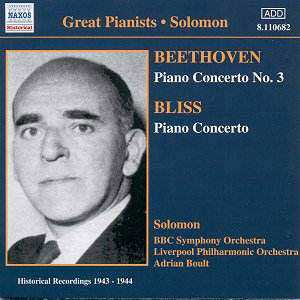Another splendid Naxos Solomon disc, this time of the two Concerto
performances recorded during the latter stages of the War of works closely
associated with the pianist. He had first played the Beethoven C Minor
in 1912 with Henry Wood at Queen’s Hall and his later recording, from
his complete cycle, with Herbert Menges and the Philharmonia has tended
rather to obscure the qualities of this 1944 traversal which are very
considerable indeed. It begins in emphatic form with strong string fortes
from Boult alternating with woodwind diminuendos. Solomon himself enters
to coruscate with some rhythmic impetus in the left hand from 4’50 – his
balancing between the hands is magnificent – and there is evidence everywhere
of the superiority and sophistication of his rhythmic and tonal reserves,
never paraded, always turned inwards to the source of the score itself.
The war-depleted BBC Orchestra manage crisp attacks; their very distinctive
woodwinds and the oboe (I assume it’s Terence McDonagh) make strong contributions
and galvanise the movement. As was his wont Solomon plays the Clara Schumann
cadenza – probably introduced to him by his teacher Mathilde Verne, herself
a famous Clara Schumann pupil.
It’s a commonplace of course but it has to be said
nevertheless; Solomon phrases the second movement with such simplicity
and honesty that other pianists sound gauche or point scoring in his
wake. The gradients of his tone and the proportionate ascending runs
weighted with absolute naturalness are but two examples of the remarkable
artistry of the pianist. Boult himself sensitively withdraws volume
to match his soloist suffusing the movement with a grave delicacy. And
how well Boult moulds the violins’ counter theme in the Rondo finale,
how well both oboe and clarinet sing out and how vigorous and life enhancing
is Solomon’s playing.
The Bliss Concerto was written for Solomon who premiered
it at the New York World Fair in 1939, for which it had been commissioned,
where it was played at Carnegie Hall with Boult at the helm of the New
York Philharmonic. In his memoirs Bliss remembered Solomon nervously
pacing up and down backstage before that June 1939 premiere wondering
aloud whether he could go out and play at all. In 1943 with the then
leading British Orchestra, the Liverpool Philharmonic, Solomon made
a recording of the work, produced by Walter Legge, and again conducted
by Boult. The hyper-Romantic virtuosity of its syntax holds no fears
for Solomon. In the first movement’s virtuosic but stentorian opening
– which encloses a remarkably static outburst – he is fully in control
of the tricky rhythmic patina of the work. The orchestral instrumentalists
make their presence felt as well – flute, clarinet (Reginald Kell?)
and violin (presumably Henry Holst) all bring real distinction to the
movement. But always with Solomon bravura is integrated, virtuosity
subsumed to musicality; listen from 12’00 to the quicksilver changes
of mood and from 13’45 where there is absolutely no forcing or playing
through the tone even at this dramatic structural juncture towards the
movement’s close. In the second movement Solomon reveals his chamber
instincts for coalescing the faster and slower sections, for exchanges
with orchestral soloists, for exploring the sometimes complex Romanticism
at the heart of the Theme and Variations. Boult meanwhile encourages
sensitive phrasing from the strings in response. The rather Russian
finale is notable for some fascinating piano/woodwind exchanges and
for Solomon’s traversing of the demanding piano part with extraordinary
control. The final tremendous peroration, with its dramatic diminuendo
and final outburst, is a real tour-de-force, one through which Solomon
and Boult manoeuvre with real panache.
The transfers are excellent and the presentation comprehensive
and thoughtful. Very strongly recommended.
Jonathan Woolf


